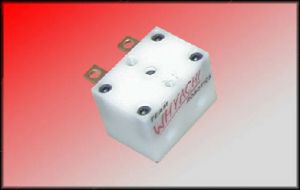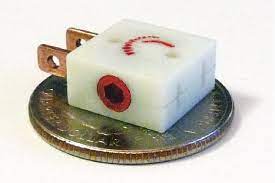Switches
Power Switches
Although some people will choose to power-on their robots by simply plugging in their batteries, this approach is only suitible for smaller robots and will usually take additional time with builders tryig to secure the wires before their match. Most people choose some readily available power switches to turn their robots on and off. Although many options will work, some like Hella switches require significant modifications to be suitible for robot combat.
One thing designers need to consider is how to safely access the robot's power switch when it is active. Remember weapon and drive systems may not be working properly after a match, so place your switch away from moving parts. Additionally, in larger robots think about being able to access the switch without having to flip over the robot.
Nano Power Combat Robotics Switch
This very simple switch uses a screw to contact to conductive pads to complete the circuit. At <1g, it is suitible for tiny 150g robots and for 1lb robots that don't draw a lot of current.
Fingertech
This tiny 2.15g switch is extremly popular. It is well built, affordable, and can handle up to 40amps making it suitible for many smaller to medium sized robots. It is activated by a 3/32" hex wrench.
Whyachi MS-05
The smaller switch from Team Whyachi weighs 1oz making it much too big for insect sized robots but it will easily handle 140amps for a 3 minute match making it great for medium sized weapon systems and sometimes, full-sized robot drive systems. It is activated by a 5/32 hex wrench.
Whyachi MS-2
This big switch chomes in at 5oz but can handle tremndous amounts of current and is suitible for most large weapon systems. One challenge with these switches is how then handle higher voltages. The 5/32" hex wrench can be slow to make it's connection which can result in electrical arching and carbon build-up on the contactors. There are some high-voltage add-ons which can reduce the problem.

